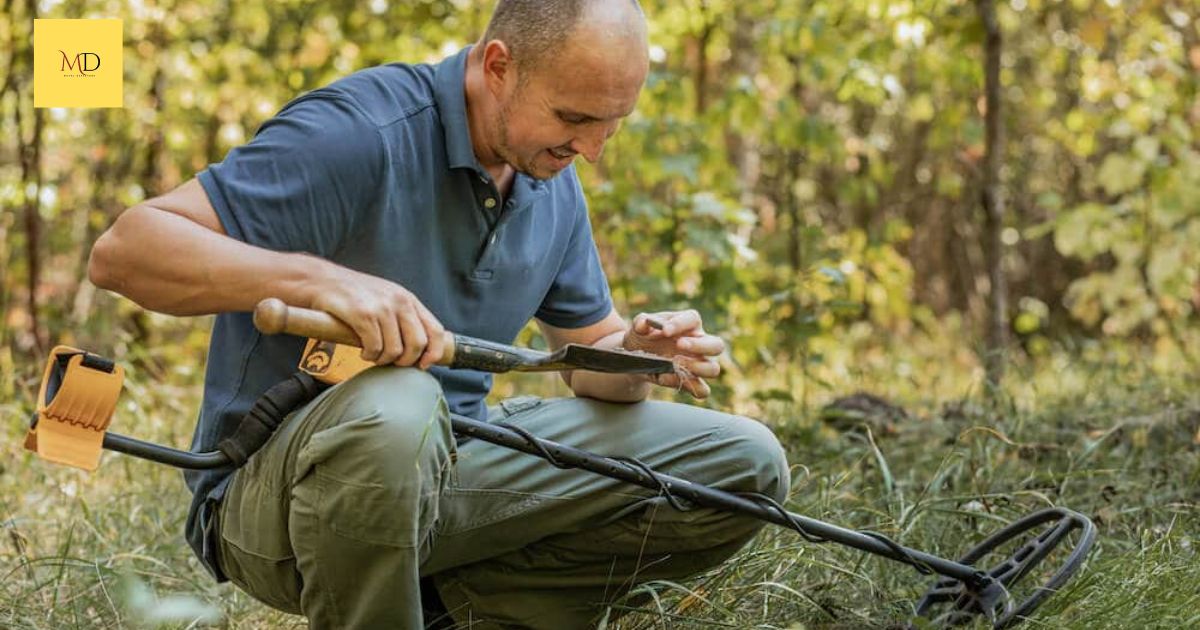A metal detector is a device that can locate metallic objects hidden beneath the ground or in various materials. It operates by generating a magnetic field and detecting disruptions caused by metal objects. Metal detectors are commonly used for security purposes to find weapons or contraband, as well as in hobbies like treasure hunting to locate buried valuables. They are also employed in industrial settings to identify and remove metal contaminants from products during manufacturing.
Are you intrigued by the allure of hidden treasures, wondering if a metal detector can unearth the glittering promise of gold? The answer is within reach Does a metal detector detect gold? Let’s embark on a journey to uncover the truth and discover your potential fortune today.
A metal detector can detect gold since gold is a highly conductive metal, and most metal detectors are designed to find a variety of metals, including gold. However, the depth and size of the gold item, as well as the metal detector’s sensitivity and settings, will affect the detection capability.
Detecting Gold with a Metal Detector
Detecting gold with a metal detector is an exciting and rewarding endeavor for treasure hunters and prospectors alike. Gold, being a highly conductive metal, can be effectively located by most metal detectors. The key to success lies in understanding the specific factors that influence detection, such as the size and depth of the gold item, the sensitivity and settings of the detector, and the surrounding ground conditions.
Prospectors and enthusiasts looking to strike gold often embark on this journey with specialized equipment and a keen sense of strategy. By fine-tuning the metal detector’s settings, interpreting signals, and adopting the right search techniques, individuals can optimize their chances of discovering valuable gold nuggets or hidden treasures, making the adventure of detecting gold with a metal detector a captivating pursuit for many.
Types of Metal Detector
Metal detectors come in various types, each designed for specific purposes and applications. One common distinction is between Very Low Frequency (VLF) detectors and Pulse Induction (PI) detectors. VLF detectors are popular among hobbyists and treasure hunters due to their versatility. They work by emitting a low-frequency electromagnetic field and can discriminate between different types of metals, making them suitable for coin and relic hunting.
Another category is Multi-Frequency detectors, which have gained popularity for their ability to operate at multiple frequencies simultaneously. This makes them effective at detecting a wide range of targets, from small coins to larger relics. Multi-Frequency detectors offer versatility and are suitable for both beginners and experienced detectorists. The choice of the type of metal detector largely depends on your specific needs, the environment you’ll be searching in, and the types of targets you hope to find, allowing you to tailor your equipment to your metal detecting goals.
Gold Detection Techniques
Gold detection techniques are crucial for treasure hunters and prospectors looking to uncover this precious metal. These techniques involve a combination of knowledge, skill, and the use of advanced metal detecting equipment. One key aspect is understanding ground conditions, as different terrains can impact a detector’s performance. Prospectors often need to adjust the detector’s sensitivity and discrimination settings to filter out unwanted signals and focus on gold.
To master gold detection techniques, it’s essential to be aware of various environmental challenges. Ground mineralization, hot rocks, and interference from other electronic devices can create false signals. Prospecting in different locations, using proper ground balancing, and employing discrimination features can help minimize these challenges. By combining knowledge of the terrain, the right detector settings, and a keen eye for signals, gold hunters can increase their chances of making thrilling discoveries and unearthing the hidden treasures of this precious metal.
Limitations and Challenges

When it comes to using metal detectors for gold detection, there are certain limitations and challenges that prospectors and hobbyists should be aware of. One of the primary challenges is the depth of the gold deposit. Metal detectors have varying detection depths, and while they can locate small gold nuggets close to the surface, detecting deeper deposits can be more challenging. Additionally, the size of the gold object plays a significant role in detection; smaller gold particles may not register on the detector’s screen.
Environmental factors also pose challenges. Mineralized soil, hot rocks, and other metals in the vicinity can create interference and generate false signals, making it difficult to distinguish between valuable gold and unwanted materials. Seasonal changes in ground conditions can impact detection capabilities as well. Furthermore, metal detectors may not be as effective in identifying gold in highly mineralized areas, as the detector’s sensitivity and settings must be constantly adjusted to account for varying conditions.
Success Stories
Success stories in the world of metal detecting are a testament to the thrill and promise of this hobby. Many enthusiasts have uncovered hidden treasures, including gold, that not only carry monetary value but also a sense of adventure. From amateur treasure hunters to seasoned prospectors, these stories serve as inspiration for those who seek to embark on their own metal detecting journey.
One remarkable success story comes from a small-town treasure hunter who, after years of meticulous searching, stumbled upon a cache of gold coins buried in his backyard. Another story tells of an archaeological enthusiast who uncovered a centuries-old gold artifact while exploring an ancient site. These success stories not only highlight the potential financial gains but also the sense of wonder and historical significance that metal detecting can bring.
Factors Influencing Detection
Factors influencing the detection of gold or any metal with a metal detector are crucial to understanding how effective the process can be. Several key elements come into play. First and foremost is the type of metal detector being used. Different detectors employ various technologies, such as VLF (Very Low Frequency) or PI (Pulse Induction), and their performance can vary. The second significant factor is the mineralization of the ground where you’re searching..
Other important factors include the detector’s sensitivity settings, which can be adjusted to suit the specific conditions and the target size. Additionally, the skill and experience of the detectorist can greatly influence detection success. Knowing how to interpret signals, discriminate between different types of metal, and properly ground balance the detector can make a significant difference in finding gold.
Understanding Ground Conditions
Understanding ground conditions is crucial for successful metal detecting. The composition and mineral content of the soil can significantly affect a metal detector’s performance. Different ground conditions, such as highly mineralized soil or areas with a high iron content, can lead to increased interference and false signals. Therefore, it’s essential for detectorists to adapt their settings and techniques based on the specific ground conditions they encounter.
To gain a better grasp of ground conditions, detectorists often conduct tests and use ground balancing features on their detectors. Ground balancing helps neutralize the impact of mineralization, making it easier to detect metal objects accurately. Additionally, understanding local geology and researching the history of an area can provide valuable insights into the likely ground conditions, allowing detectorists to make informed decisions on where and how to search for treasures.
Multi-Frequency Detectors
Multi-frequency detectors, also known as multi-frequency metal detectors, represent a significant advancement in the world of treasure hunting and metal detection technology. These detectors are designed to emit and receive multiple frequencies simultaneously, which allows them to provide a more comprehensive and accurate picture of what’s beneath the ground. This innovation enables them to excel in a variety of detection scenarios, from finding small, shallow targets to detecting larger, deeper objects.
One of the key advantages of multi-frequency detectors is their versatility. They can be used for various types of metal detecting, including coin shooting in parks, beachcombing, and relic hunting in historical sites. Their ability to adapt to different search conditions and their improved discrimination capabilities make them a popular choice among both novice and experienced detectorists. In summary, multi-frequency detectors have significantly expanded the capabilities of metal detection technology, making it easier for enthusiasts to uncover hidden treasures and artifacts in a wide range of environments.
FAQ’S
Do metal detectors detect gold or silver?
Yes, metal detectors can detect both gold and silver, as these metals have distinctive conductivity and magnetic properties that make them detectable by most standard metal detectors.
How deep can a metal detector detect gold?
The depth at which a metal detector can detect gold depends on several factors, including the size and type of the gold object, the metal detector’s technology and settings, and the ground conditions.
Can I detect gold with my phone?
No, you cannot detect gold with your phone. Mobile phones are not equipped with the necessary technology to detect or identify gold or other metals. Gold detection typically requires specialized metal detectors designed for this purpose.
Conclusion
Metal detectors have revolutionized the world of treasure hunting and security, making it possible to locate a wide range of metallic objects, including gold. The effectiveness of detecting gold with a metal detector depends on various factors such as the size and type of the gold, the detector’s technology, and the ground conditions. While small gold nuggets may be detected at shallow depths of just a few inches to a foot, larger gold objects can be found at even greater depths, sometimes extending to several feet. The capability of multi-frequency detectors, in particular, has greatly expanded the horizons of gold prospecting and other metal detecting endeavors.
As technology continues to advance and new innovations emerge, the potential for metal detectors to detect gold at even greater depths and with increased accuracy is an exciting prospect. Metal detecting enthusiasts and gold prospectors alike are sure to benefit from these advancements, opening up new possibilities for discovery. So whether you’re a seasoned treasure hunter or just starting out, the thrill of uncovering gold with a metal detector remains an enduring and captivating pursuit for adventurers of all ages.











